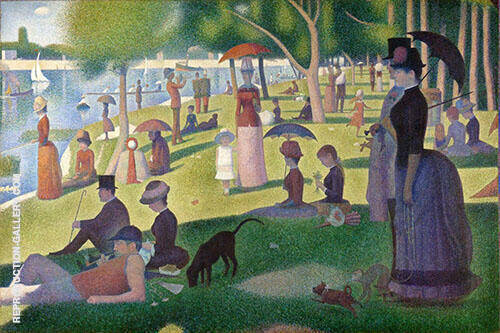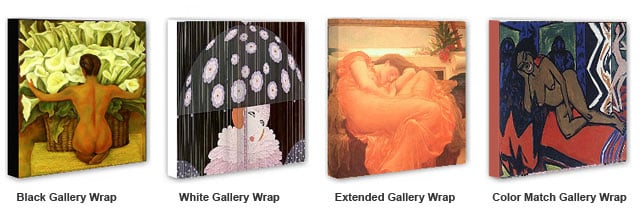A Sunday on La Grande Jatte By Georges Seurat
Georges Seurat A Sunday on La Grande Jatte
A Sunday on La Grande Jatte is known in French as “Un Dimanche après-midi à l'Île de la Grande Jatte”. This astounding Pointillism painting is a prime exemplification of Georges Seurat art.
Created between 1884 and 1886, it is one of the most famous Georges Seurat paintings. The artwork measures approximately two by three meters in size.
What does Georges Seurat Painting A Sunday Afternoon Represent?
Representing a group of fashionable Parisians sitting on the beautiful banks of the flowing River Seine, the painting also demonstrates Georges Seurat's new and rebellious artistic techniques. While creating his oil painting, Seurat mainly focused on the landscape. He produced several preliminary sketches of the landscape and figures before settling on the final composition. During this period, Seurat frequently sat on the banks of the river. He also spent significant time observing people, light, and society figures bathing in the French sunshine.
The Island of La Grande Jatte itself sits on the outskirts of the city of Paris. It lies in the middle of the River Seine, between the neighborhoods of Neuilly and Levallois-Perret. The island was an industry hub for many years before transforming into a bucolic public garden. When Seurat painted Sunday Afternoon, the park was a firm favorite amongst Parisian elites.
The painting also mirrors the composition of an earlier work, Bathers at Asnieres 1884, which depicts Paris’ industrial history. In this work, factory smoke and chimneys rise in the distance. However, while Seurat’s working-class bathers rest in direct sunshine, Sunday Afternoon casts each figure in shadow. Amongst fashionable Parisian society, Sundays were a time to leave the busy and sweltering Paris city center and head for the cool breeze of the many parks adjoining the River Seine.
Understood in this context, the young boy in the more lower-class Bathers at Asnières scene calls out to his upper-class compatriots on the opposite bank of the Seine.
Who are the people in Sunday on the Grande Jatte?
Many individual characters appear in this Georges Seurat artwork, and it’s thus worth exploring each in turn.
Within the painting, Seurat depicts a fashionable couple on the right-hand side of the composition. The man wears a top hat, and the woman holds a sunshade while strolling through the park. Another well-dressed woman (situated to the left of the composition) strangely participates in a spot of river-fishing.
Other notable figures include a woman knitting, two soldiers listening to a trumpeter, and another lady sitting under the glow of an orange umbrella. While the scene appears straightforward, many characters participate in unusual activities. For instance, a woman on the right-hand side holds a monkey on a lead. In addition, the woman fishing on the riverbank references the park’s infamy as an area for prostitution among the bourgeoisie.
Even more intriguing is the small girl standing in the center of the composition. She stares directly at the viewer, inviting our response to the strange and unusual scene. Social upheaval prevailed in French society at the time (with the rise of the Industrial Revolution). With this in mind, Seurat encourages our judgment, perhaps by posing, "Should the upper classes bathe in the shade while others toil in factories on the river?
What type of art is Sunday on the Island of La Grande Jatte?
Sunday Afternoon is a wonderful illustration of Georges Seurat's Pointillism art. Originating in France in the mid-1880s, Georges Seurat was the movement's first and principal proponent.
Pointillism refers to paintings where small dots gradually come together to form a complete image. Although initially coined by art critics to mock the work of Georges Seurat and Paul Signac, Pointillism was a revolutionary technique.
Pointillism relies on the mind’s unique ability to blend dabs of color into fuller tones and shapes. It also directly contrasts the traditional Classicism previously favored by the French Academy. Deeply inspired by the scientific color theory of Michel Eugène Chevreul and Ogden Rood, Seurat adapted their pioneering ideas to astounding effect in Sunday Afternoon on the Island of La Grande Jatte.
If one gazes closely at the painting, thousands of miniature dots and fleeting brush strokes appear. Stepping back, however, these marks unify into one coherent and cohesive whole. Seurat believed this technique made colors more powerful and vibrant than traditional approaches.
As well as Pointillism, A Sunday Afternoon on the Island of La Grande Jatte represents Seurat’s work within the Neo-Impressionist movement. The French art critic Felix Feneon coined the term, referencing Georges Seurat and his contemporaries.
These artists depicted modern urban scenes, landscapes, and seascapes with scientific diligence and the latest avant-garde techniques.
How was Sunday Afternoon on La Grande Jatte created?
Seurat painted La Grande Jatte in three distinct phases.
- In the first phase, between 1884 and 1885, he mixed paints from several individual pigments, relying on traditional colors and tones.
- In 1885-86, he revolutionized his process and dispensed with earth-based pigments entirely. Henceforth, Seurat utilized vibrant dots of pure color in a true pointillist technique that mixed in the viewer’s eye instead of on the canvas.
- The third painting phase occurred from 1888 to 1889 when Georges Seurat added a colored border to his oil painting.
Fascinatingly, the border is painted in inverted colors, directly contrasting with the central painting. While Seurat’s intention is uncertain, this could represent the slowly shifting and inverting world of modern French society that the artist loved to paint.
How much is Sunday on La Grande Jatte worth?
Currently held by the Art Institute of Chicago, the painting is valued at over $650 million. It was acquired in 1924, and it is thought they originally paid just $24,000.
The artwork was exhibited initially at the Eighth Impressionist Exhibition in May 1886. The painting met with considerable public acclaim. Then, in August 1886, it was shown again when it dominated the Second Salon of the Societe des Artistes Independants.
Seurat transformed the relationship between art and science with his famous painting. With his establishment of the Pointillist and Neo-Impressionist schools, Georges Seurat's artworks fundamentally changed the history of art. European art and society would never be the same again.
Discover famous oil paintings by other Pointillist artists, Jan Toorop, Camille Pissarro, and Henri Edmond Cross. Browse our unparalleled collection of famous Georges Seurat oil painting reproductions to find the perfect paintings for your walls.
We offer a 100% money back guarantee or replacement service. If for any reason you are dissatisfied with your painting please contact us within 7 days of receipt, advising the reason you are unhappy and we will provide you with all the information you need for its return or replacement.
We ship free to anywhere in the world via FedEx or DHL expedited service with online tracking.
Your painting will be shipped rolled in strong plastic tubing, ready for stretching and/or framing locally. This is the conventional method of transporting hand-painted oil on canvas. Learn more about how your painting is shipped.
We are able to offer a framing service intercontinental U.S. Please contact us if you would like a quotation. Alternatively, should you prefer, we can recommend a framer in your area.
Notes About Your Painting
Please note that replica oil paintings are finished with an additional 10cm (4") of extra canvas on all sides, allowing ample surplus canvas for stretching and framing.
Cannot Find What You Are Looking For?
Reproduction Gallery Information
Customer Service
(Send Us A Message)
Tel: (503) 937 2010
Fax: (503) 937 2011








